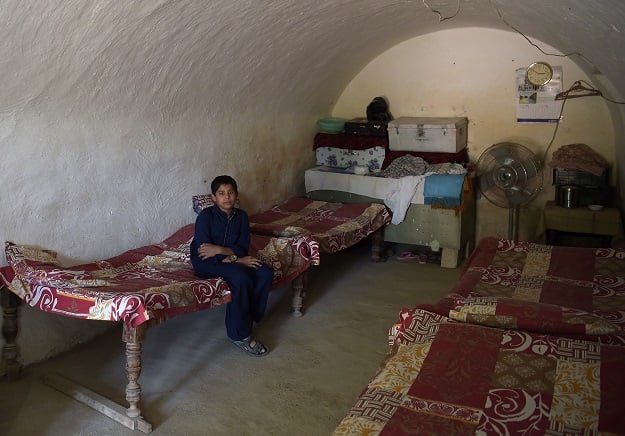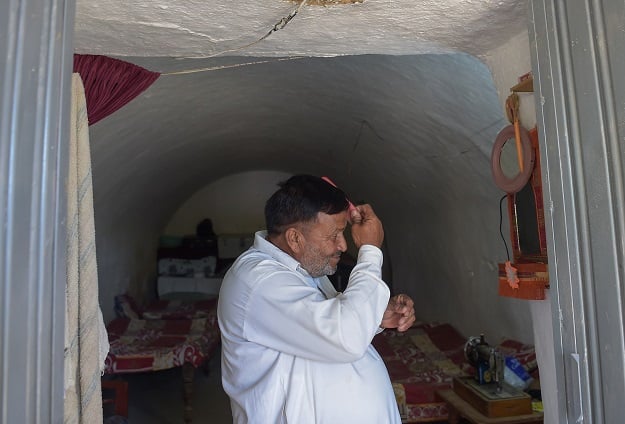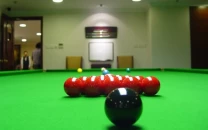The cave-dwellers of Hasan Abdal
Nearly 3,000 people live in caves in the village

Pakistani villager Faqeer Gul offers noon prayers in his cave room in Nikko village, about 60 kilometres from the capital Islamabad, near the highway town Hasan Abdal
PHOTO: AFP
Located around 60 kilometres from the federal capital, nearly 3,000 people live in caves in the village of Hasan Abdal, according to councilor Haji Abdul Rasheed - whose own home is among the dwellings carved into the rugged, earthen hillside embankments.
Rasheed's spartan cave - or 'buray' as it is locally known - consists of a few minimally furnished rooms complemented by a breezy veranda.
 Ameer Ullah Khan washes his hands outside his cave home in Nikko villagePHOTO: AFP
Ameer Ullah Khan washes his hands outside his cave home in Nikko villagePHOTO: AFP‘PHA to overcome financial crisis’
The caves are usually dug by hand, with residents using clay to plaster the walls - a practice which serves as a bulwark against landslides, they say.
"There is nothing like it. If you build a mud house, it collapses during the rains. This does not collapse," says Rasheed. "It's earthquake-proof and bomb-proof."
VIDEO: Bomb-proof, earthquake-resistant and cheap: thousands of Pakistanis are choosing to hunker down in caves northwest of Islamabad, snapping up the hobbit-like homes amid a nationwide housing shortage pic.twitter.com/DXzY9yOxlZ
— AFP news agency (@AFP) November 20, 2018
Although locals have been living in caves for at least five centuries since the area was settled by a Mughal tribe, a surge in housing prices has renewed the appetite for the cavernous homes, which cost much less than their urban counterparts.
"We bought this because it's cheaper... we dug it ourselves," says resident Ameer Ullah Khan.
The modern-day cave dwellers also recommend the structures as ideally suited to Pakistan's weather - staying cool as summertime temperature soar past 40 degrees Celsius and providing a warm cocoon during the area's chilly winters.
 Ameer Ullah Khan chats with a friend in his cave room in Nikko villagePHOTO: AFP
Ameer Ullah Khan chats with a friend in his cave room in Nikko villagePHOTO: AFP"We mostly spend our summers here... using the caves as our residence and to store our belongings, including our wheat and corn harvest," says Muhammad Sohail, who lives elsewhere the rest of the year.
Life is not all easy however: lacking sufficient natural light, the caves rely on electricity cabled in from outside to power TV sets and mobile phones, while indoor plumbing is a rare luxury.
 A young Pakistani villager sits in a cave roomPHOTO: AFP
A young Pakistani villager sits in a cave roomPHOTO: AFPBut with cave prices averaging around about 40,000 rupees compared to brick homes that start around 250,000 rupees, locals and property experts say they are much more affordable than other rural options.
"Even in the countryside, you need at least half a million rupees to get a small piece of land to build a house," real estate agent Sakhi Riaz told AFP.
Conservation only way to ward off water crisis
The lower costs have allowed some residents to splurge on extras, from rose gardens to terraced fruit orchards.
One local 'godman' has even gone so far as to build an huge residential complex to host hundreds of devotees who flock to the area for religious festivities.
 Haji Abdul Rasheed combs his hair at the entrance to his cave roomPHOTO: AFP
Haji Abdul Rasheed combs his hair at the entrance to his cave roomPHOTO: AFPThe humble abodes are seen as an increasingly attractive option as the country battles a dearth of affordable housing, with the country's rapidly growing population hovering around 207 million.
Freshly elected Prime Minister Imran Khan has vowed to address the crisis by building as many as five million new homes even as an ongoing financial crisis has raised questions about how he will pay for it.


















COMMENTS
Comments are moderated and generally will be posted if they are on-topic and not abusive.
For more information, please see our Comments FAQ